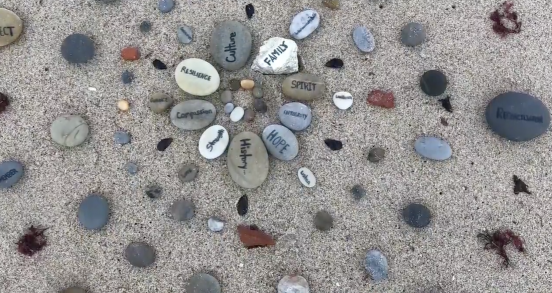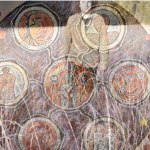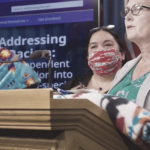Mandala Blog:
After much deliberation and restlessness, my “Spoken Letters” gift took shape in the form of a mandala. By marking stones found on the beach with words and themes I heard in the stories of the Mikmawey Debert Cultural Centre survivors’ stories, and arranging them, I created a mandala. This was a very difficult task as I wanted to honour rather than insult or let down the survivors who were brave enough to share their stories.
I deliberately chose to introduce myself by using my parent’s names as this is how many survivors chose to introduce themselves. When I reflected on this, I appreciated how my name carries significant meaning to me, but not the same to strangers. Situatingmyself in the lives of my parents and ancestors felt appropriate as my life is inherently tied to them. On the other hand, my nameto a stranger might ring hollow. I felt connecting myself to that history added richness and mirrored the introductions provided by the survivors.
I used the beach background because I wanted the focus to be on my words, and to carry a connection to nature without overdoing the stimuli/images. As discussed later, this beach is of significant because it sits in close proximity to where explorers would have set off from, prior to connecting with Indigenous communities.
I chose to speak about Alert Bay because that community provided me with significant learning opportunities in understanding the first-hand experiences of survivors and their families. The richness of the community and the depth of the pain felt by survivorsbrought me understandings and I felt it was important to follow up who I am in the world by sharing where some of my knowledge around residential schools comes from— not just academia. The quote I used about the red shining through bricks previously painted white was a refrain I heard from multiple people, across generations, in Alert Bay. The quote was always a representation of strength. I attempted to balance that strength with the incredibly haunting graffiti on St. Michael’s Residential School. I realize I run the risk of being risqué in using a red/white analogy, but this is how that knowledge was shared with me. The graffiti was intended to illicit a sense of the dark reality of what took place, and the quote was aimed at balancing that reality with hope in common language.
I have always found Senator Murray Sinclair as a beacon of hope and strength for First Nations across our country. He is someone I admire. The quote I chose is directed towards the racist attitudes of people who regularly put forward the false and immoral “get over it,” notion. I always find this quote poignant.
I chose to do a mandala for several reasons. Firstly, I liked the shape as a symbol of interconnectivity and balance. The mandala allowed me to incorporate the themes and words from the survivors’ stories. As well, the mandala draws from Hinduism, a framework that guided my family and has understandings that echo through my life.
I felt using the words of the survivors was critical, because it was their chosen words that I was reading. I also liked the balance the mandala brought as reconciliation requires both survivors and their relations as well as fellow Canadians to both understand and act. The fluidity between the words was appealing as each could be connected to one another. Notably, I am more of an appreciator of art than an artist. One of my favourite carvers in Alert Bay told me, “the mother of invention is necessity,” so in an act of full disclosure, the mandala also spared you from my rhyming couplets or iambic pentameter!
I knew that I wanted to have nature feature in my project as the respect First Nations show to the natural world holds significant appeal to me and philosophically shows an understanding of our connections with all forms of life and the environment. I am presently on holidays in Portugal and Spain, so the opportunity to use the beach was also appealing. In literature I understand the ocean as a metaphor for the soul, so working there brought a sense of poeticism— this is where things changed and many souls were impacted. In doing some research I understand Christopher Columbus and others set sail within a couple hundred kilometers of the beach that I videoed.
Choosing to write on rocks was also a deliberate choice, as I had an earlier thought of placing paper down. Rocks carry the earth’s history, last a long time and take time to transform. Eventually, the waters will wash the ink from the stones and after years, transform the rocks into sand. I’m hoping this is symbolic of the harms inflicted upon residential school survivors and their relations can be remedied, and of the transformation needed for reconciliation amongst fellow Canadians. I ended with the quote from Senator Murray Sinclair because I felt it stood strong independently, (without my voice), pointing out everyone’s involvement in reconciliation.
Roby Sharma





